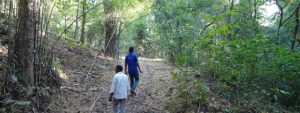Bhimgad Wildlife Sanctuary:

Public trespassing into the ecologically sensitive Bhimgad Wildlife Sanctuary (BWS) in Khanapur taluk continues unchecked, raising serious concerns among conservationists.
- Bhimgad Wildlife Sanctuary spans over the Western Ghats in the Belgaum district of Karnataka.
- It was declared as a wildlife sanctuary in December 2011.
- The sanctuary has been named after the Bhimgad Fort, constructed and commanded by Shivaji Maharaj in the 17th century as a defence from Portuguese troops.
- It shares its boundary with the north of Dandeli Wildlife Sanctuary, north-west of the Bhagwan Mahaveer Sanctuary and Mollem National Park, north of Netravali Wildlife Sanctuary, and east of Mhadei Wildlife Sanctuary.
- It is characterized by its diverse topography, encompassing hills, valleys, and plateaus.
- BWS forms the headwaters of a number of rivers like Tillari, Malaprabha, and Mhadei and several perennial streams.
- This sanctuary is known for the Barapede caves, the only known breeding area of the Wroughton’s Free-tailed Bat, a threatened species on the verge of extinction.
- It provides habitat for several endangered species, such as the Indian sloth bear, Indian pangolin, and the elusive black panther.
- Other notable residents include the Malabar giant squirrel, gaur, sambar deer, and a plethora of bird species, including the Malabar trogon and the great Indian hornbill.
- One of the unique features of Bhimgad is the presence of large, isolated rock formations that serve as ideal breeding grounds for the King Cobra, the world’s longest venomous snake




